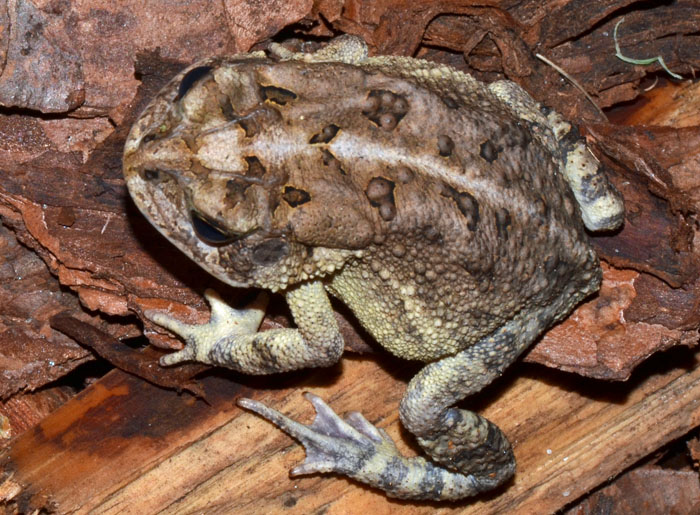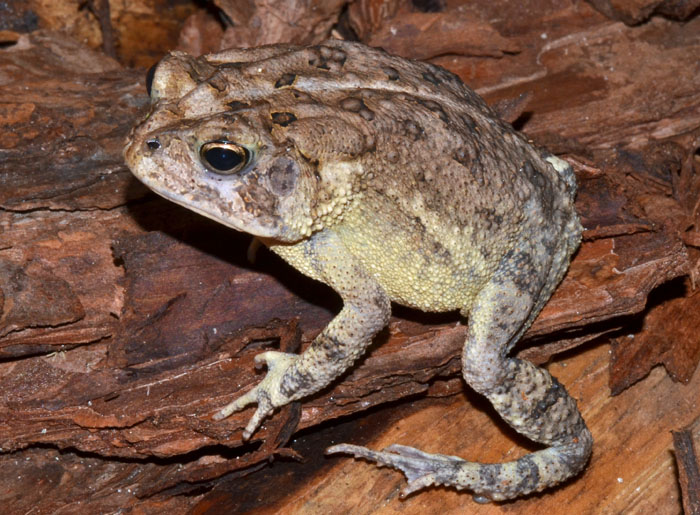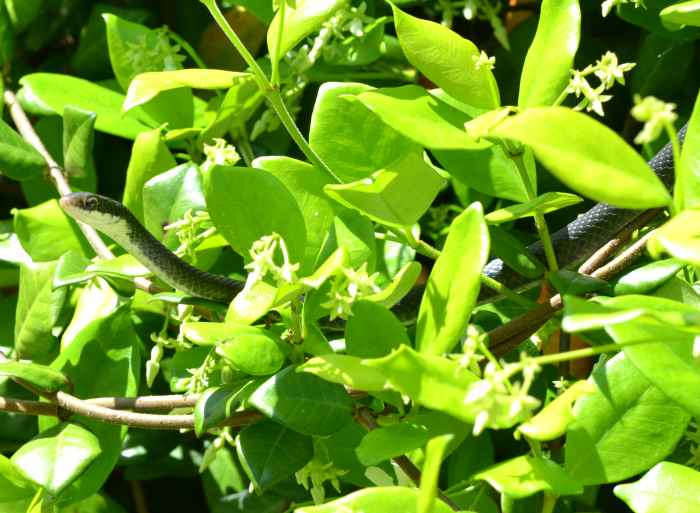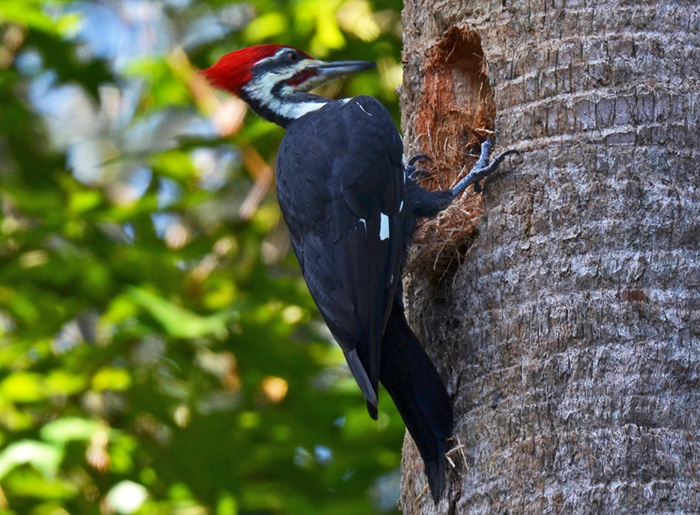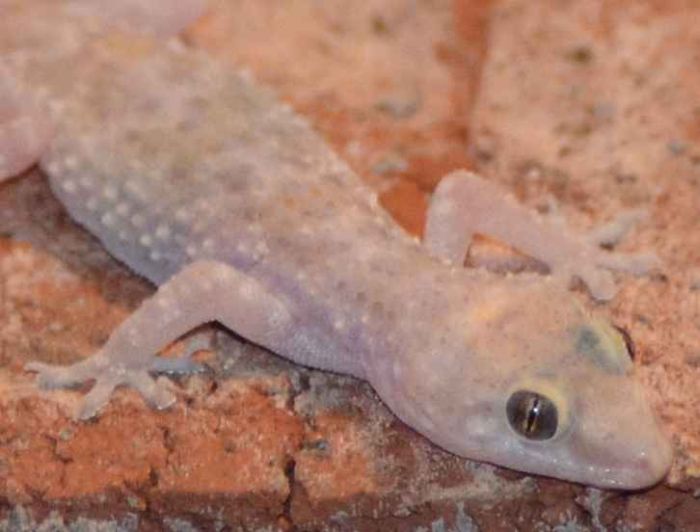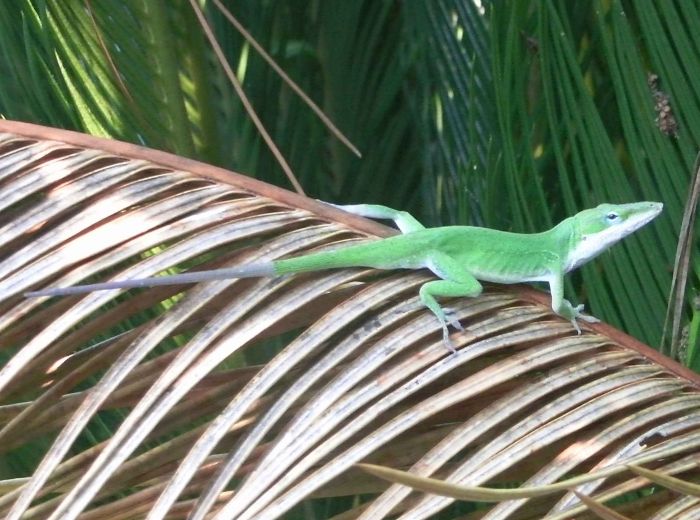 Anolis carolinensis (Green Anole). | We have plenty of these common lizards in our yard and on occasions in our living room which seems to attract
them magically. This is the green anole (Anolis carolinensis). They can drop (and regrow) their tail to evade predators. I wonder whether the darker grayish tail of the left fellow is due to such an event. They also change color to fit the situation. Brown indicates distress. They eat small insects such as moths and crickets. wikipedia: http://en.wikipedia.org/wiki/Carolina_anole wildflorida.com: http://www.wildflorida.com/florida_lizards.php | ||
 Bufo terrestris (Southern Toad). | The Southern Toad (Bufo terrestris) has pronounced knobs and crests on its head. Two crests extend forward from the knobs and come close to one another near the snout. It has only one or two warts. Secretion from the parotoid glands (located at the back of the head) is not toxic but might act as an irritant to human mucous membranes.
UF: http://www.wec.ufl.edu/extension/wildlife_info/frogstoads/bufo_terrestris.php | ||
 Coluber constrictor priapus (Southern Black Racer). | This snake surprised me while I was looking for insects in my beautiful jasmine-covered trellis. It seems to be a Black Racer (Coluber constrictor priapus). They can reach a length of over 60 inches and feed on rodents, frogs, birds, and lizards. They kill they prey by suffocation or crushing. This snake held itself in the jasmine at a height of approx. 6 ft. and did not move at all.
wikipedia: http://en.wikipedia.org/wiki/Coluber_constrictor_priapus | ||
 Cyanocitta cristata (Blue Jay). | This birdie looks a bit tired and doesn't show its pretty crown of feathers. It was early in the morning and perhaps it had rained. Anyway I shot this picture through the small window of our guest bathroom, which allowed me to get pretty close.
Blue jay (Cyanocitta cristata). These birds are rather loud and can imitate other birds (hawks) as well as human voices (this one didn't). wikipedia: http://en.wikipedia.org/wiki/Blue_jay | ||
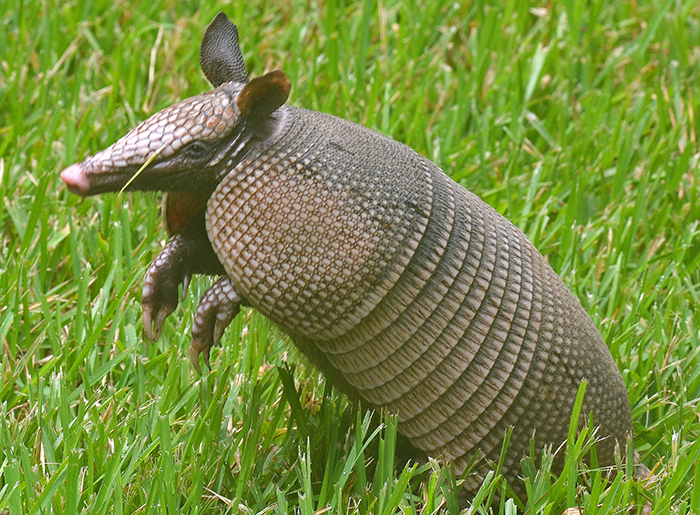 Dasypus novemcinctus (Nine-Banded Armadillo). | Armadillo is Spanish for "little armored one" but German setllers in Texas
called them "Panzerschwein". When I took these photos, the armadillo ignored
me for a rather long time and then suddenly run away. The small photo was taken way back on 7/4/2004 around 11 pm.
wikipedia: http://en.wikipedia.org/wiki/Nine-banded_Armadillo | ||
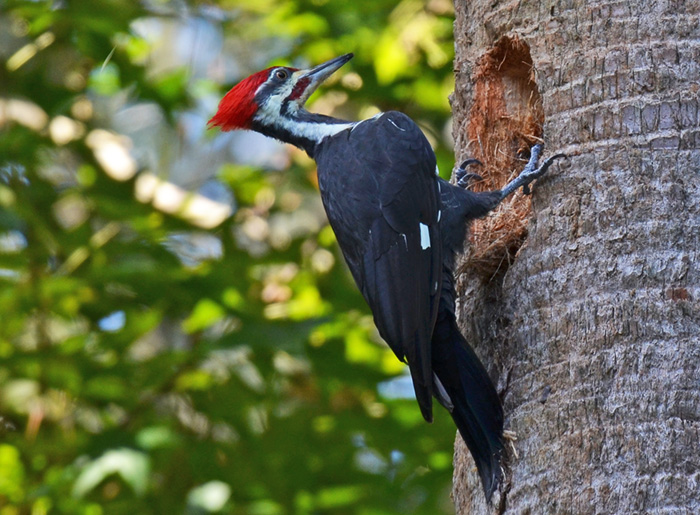 Dryocopus pileatus (Pileated Woodpecker). | I caught this beautiful wood pecker on our tall palm tree. Pileated woodpeckers mainly eat insects, especially carpenter ants and wood-boring beetle larvae, but also fruits, nuts, and berries. They excavate their large nests in dead trees, which can cause smaller trees to break in half. Pileated woodpecker pairs stay together on their territory all year round.
wikipedia: https://en.wikipedia.org/wiki/Pileated_woodpecker | ||
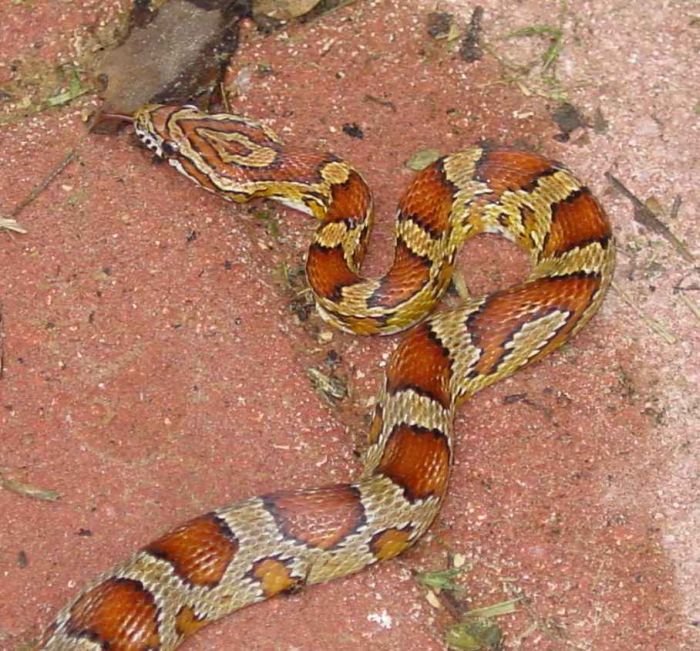 Elaphe guttata (Corn Snake). | I found this one under my garbage can (twice over 12 years). This could be a corn snake (Elaphe guttata). They reach lengths of up to 6' and are not dangerous to humans, but then again doesn't the venomous copperhead look very similar? wikipedia: http://en.wikipedia.org/wiki/Corn_snake | ||
 Eumeces laticeps (Broadheaded Skink). | more later. | ||
 Euparius paganus. | ... and this weevil is in the sister species Euparius paganus. bug guide (this photo): https://bugguide.net/node/view/996316 | ||
 Hemidactylus turcicus (Mediterranean Gecko). | The Mediterranean Gecko has sticky toe pads and vertical pupils. Its skin is bumpy/warty. This introduced old-world species is almost completely nocturnal. It is firmly established in Florida and always found close to human developments. Geckos can make squeaking or barking noises. The small photos were taken on 08/08/11 around 11 pm.
UGA: http://www.uga.edu/srelherp/lizards/hemtur.htm UF: http://www.flmnh.ufl.edu/herpetology/checklist/lizards.htm | ||
 Mimus polyglottos (Northern Mockingbird). | The ubiquitous northern mocking bird (Mimus polyglottos). It is the state bird of Florida.
Mocking birds are very territorial and rule our yard (as far as birds are concerned). They like to attack and chase other birds even crows etc. They have a large repertoire of songs (including many "imitations") which tend to be short and repetitive. wikipedia: http://en.wikipedia.org/wiki/Northern_Mockingbird | ||
 Orgyia detrita - Hodges#8313 (Fir Tussock Moth) - imm. | Citing from Wagner "Caterpillars of Eastern North America", p. 450: "The sides of the body are gray and supraspiracular warts are orange; the black middorsal stripe is flanked by yellow spots on A4-A7." The second link also describes a rather different looking, darker version of the caterpillar. The one shown here is strange because it has only three (rather than the normal four) of those distinct, beige "brushes". bug guide (this photo): https://bugguide.net/node/view/1513765 UF: https://tinyurl.com/Orgyia-detrita | ||
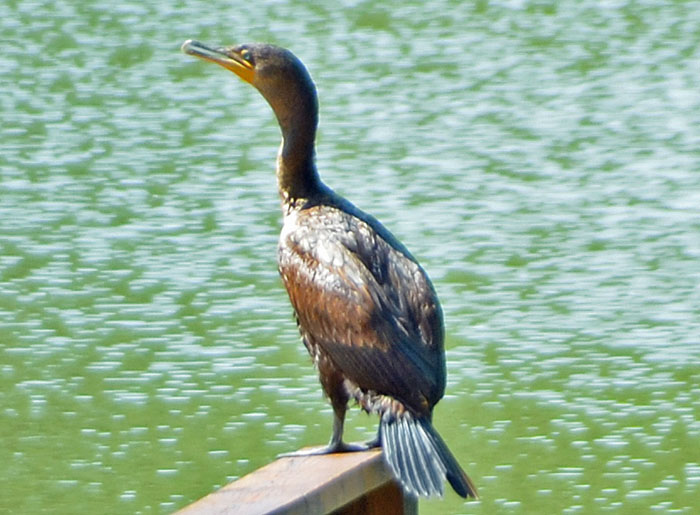 Phalacrocorax sp. (Cormorant). | This cormorant dried its wings on our little dock. Unlike the similar anhinga, it has a curved beak. I am guessing that this is a juvenile double-crested cormorant (Phalacrocorax auritus). wikipedia: http://en.wikipedia.org/wiki/Cormorant | ||
 Pomacea sp. (Apple Snail). | I was surprised to find several striking pink egg masses on my dock today. They are eggs of an Apple Snail species. Apple snails are larger than most freshwater snails and "can be separated from other freshwater species by their oval shell which has the umbilicus (the axially aligned, hollow, cone-shaped space within the whorls of a coiled mollusc shell) of the shell perforated or broadly open. There are four species of Pomacea in Florida, one of which is native and considered beneficial." The others are considered invasive because of their voracious appetite for plants. University of Florida: http://entnemdept.ufl.edu/creatures/misc/gastro/apple_snails.htm wikipedia: https://en.wikipedia.org/wiki/Ampullariidae | ||
 Sciurus carolinensis (Eastern Gray Squirrel). | The ubiquitous squirrel. They have made it into Europe and started displacing other species, especially in the UK. You can always see them in our yard but they seemingly sense my camera. Despite this basic instinct, I finally took this photo on a lazy Sunday morning. I believe this squirrel built a nest in our palm tree a few weeks ago and was quite busy hauling plant material up the tree. wikipedia: http://en.wikipedia.org/wiki/Eastern_gray_squirrel | ||
 Sylvilagus floridanus (Eastern Cottontail). | Bunnies. They are very cute
and we tolerate them (and they tolerate us). Eastern cottontail (Sylvilagus floridanus). They can run up to 18 mph
(according to wikipedia) but in my yard they usually just sit on the lawn
and stare. wikipedia: http://en.wikipedia.org/wiki/Eastern_cottontail "Here comes Peter Cottontail": http://www.youtube.com/watch?v=8mKGnIF7GRE | ||
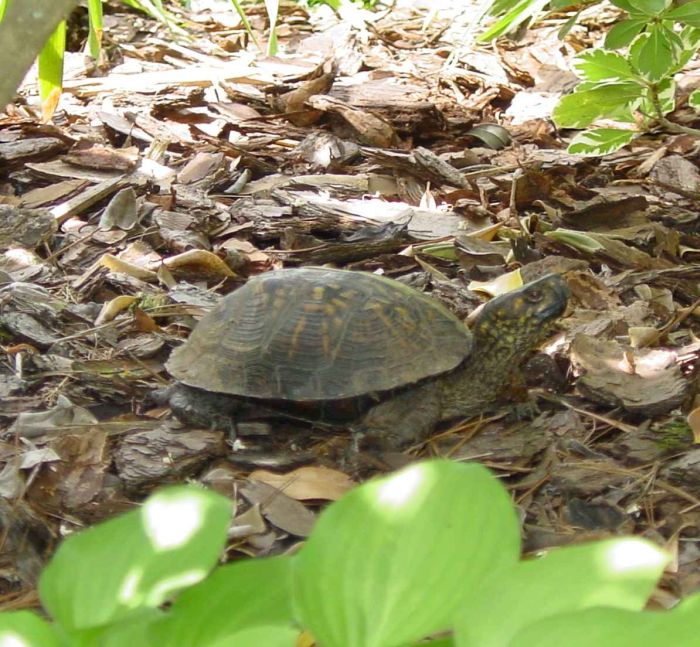 Terrapene carolina. | Another very rare visitor who appears somewhat angry about my intrusion.
More later. | ||
 Toxostoma rufum (Brown Thrasher). | Another common bird in our yard is the brown thrasher (Toxostoma rufum). It belongs to the same family (Mimidae) as the mocking bird. It seems to spend a lot of time on the ground inspecting the edges of our lawn where leaves accumulate.
Like the mocking bird, it is a prolific "singer". According to wikipedia, brown thrashers know up to 3,000 songs (sounds like they are improvising). The brown thrasher is the state bird of Georgia. wikipedia: http://en.wikipedia.org/wiki/Brown_Thrasher |

